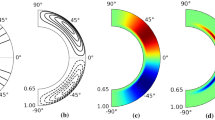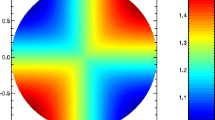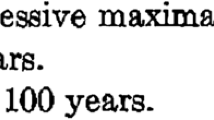Abstract
We discuss a solar dynamo model of Tayler–Spruit type whose \(\Omega \)-effect is conventionally produced by a solar-like differential rotation but whose \(\alpha \)-effect is assumed to be periodically modulated by planetary tidal forcing. This resonance-like effect has its rationale in the tendency of the current-driven Tayler instability to undergo intrinsic helicity oscillations which, in turn, can be synchronized by periodic tidal perturbations. Specifically, we focus on the 11.07-years alignment periodicity of the tidally dominant planets Venus, Earth, and Jupiter, whose persistent synchronization with the solar dynamo is briefly touched upon. The typically emerging dynamo modes are dipolar fields, oscillating with a 22.14-years period or pulsating with a 11.07-years period, but also quadrupolar fields with corresponding periodicities. In the absence of any constant part of \(\alpha \), we prove the sub-critical nature of this Tayler–Spruit type dynamo. The resulting amplitude of the \(\alpha \) oscillation that is required for dynamo action turns out to lie in the order of \(1~\mbox{m}\,\mbox{s}^{-1}\), which seems not implausible for the Sun. When starting with a more classical, non-periodic part of \(\alpha \), even less of the oscillatory \(\alpha \) part is needed to synchronize the entire dynamo. Typically, the dipole solutions show butterfly diagrams, although their shapes are not convincing yet. Phase coherent transitions between dipoles and quadrupoles, which are reminiscent of the observed behavior during the Maunder minimum, can easily be triggered by long-term variations of dynamo parameters, but may also occur spontaneously even for fixed parameters. Further interesting features of the model are the typical second intensity peak and the intermittent appearance of reversed helicities in both hemispheres.
















Similar content being viewed by others
References
Abreu, J.A., Beer, J., Ferriz-Mas, A., McCracken, K.G., Steinhilber, F.: 2012, Is there a planetary influence on solar activity? Astron. Astrophys. 548, A88. DOI .
Arlt, R.: 2009, The butterfly diagram in the eighteenth century. Solar Phys. 255, 143. DOI .
Bazylevskaya, G.A., Kalinin, M.S., Krainev, M.B., Makhmutov, V.S., Svirzhevskaya, A.K., Svirzhevsky, N.S., Stozhkov, Y.I.: 2016, On the relationship between quasi-biennial variations of solar activity, the heliospheric magnetic field and cosmic rays. Cosm. Res. 54, 171. DOI .
Beer, J., Tobias, S., Weiss, N.: 1998, An active Sun throughout the Maunder minimum. Solar Phys. 181, 237. DOI .
Bollinger, C.J.: 1952, A 44.77 year Jupiter–Venus–Earth configuration Sun-tide period in solar-climatic cycles. Proc. Okla. Acad. Sci. 33, 307.
Bonanno, A., Guarnieri, F.: 2017, On the possibility of helicity oscillations in the saturation of the Tayler instability. Astron. Nachr. 338, 516. DOI .
Bonanno, A., Brandenburg, A., Del Sordo, F., Mitra, D.: 2012, Breakdown of chiral symmetry during saturation of the Tayler instability. Phys. Rev. E 86, 016313. DOI .
Callebaut, D.K., de Jager, C., Duhau, S.: 2012, The influence of planetary attractions on the solar tachocline. J. Atmos. Solar-Terr. Phys. 80, 73. DOI .
Cameron, R.H., Schüssler, M.: 2014, No evidence for planetary influence on solar activity. Astron. Astrophys. 557, A83. DOI .
Charbonneau, P.: 2010, Dynamo models of the solar cycle. Living Rev. Solar Phys. 7, 3. DOI .
Charbonneau, P., Christensen-Dalsgaard, J., Henning, R., Larsen, R.M., Schou, J., Thompson, M.J., Tomczyk, S.: 1999, Helioseismic constraints on the structure of the solar tachocline. Astrophys. J. 527, 445. DOI .
Charvatova, I.: 1997, Solar-terrestrial and climatic phenomena in relation to solar inertial motion. Surv. Geophys. 18, 131. DOI .
Chatterjee, P., Mitra, D., Brandenburg, A., Rheinhardt, M.: 2011, Spontaneous chiral symmetry breaking by hydromagnetic buoyancy. Phys. Rev. E 84, 025403. DOI .
Cionco, R.G., Soon, W.: 2015, A phenomenological study of the timing of solar activity minima of the last millennium through a physical modeling of the Sun-planets interaction. New Astron. 34, 164. DOI .
Condon, J.J., Schmidt, R.R.: 1975, Planetary tides and the sunspot cycles. Solar Phys. 42, 529. DOI .
De Jager, C., Versteegh, G.: 2005, Do planetary motions drive solar variability? Solar Phys. 229, 175. DOI .
Dicke, R.H.: 1978, Is there a chronometer hidden deep in the Sun? Nature 276, 676.
Dikpati, M., Cally, P.S., McIntosh, S.W., Heifetz, E.: 2017, The origin of the “Seasons” in space weather. Sci. Rep. 7, 14750. DOI .
Eckhardt, B., Faisst, H., Schmiegel, A., Schneider, T.M.: 2008, Dynamical systems and the transition to turbulence in linearly stable shear flows. Phil. Trans. Roy. Soc. A 366, 1297. DOI .
Ferriz Mas, A., Schmitt, D., Schüssler, M.: 1994, A dynamo effect due to instability of magnetic flux tubes. Astron. Astrophys. 289, 949.
Galindo, V.: 2018, personal communication.
Gellert, M., Rüdiger, G., Hollerbach, R.: 2011, Helicity and alpha-effect by current-driven instabilities of helical magnetic fields. Mon. Not. Roy. Astron. Soc. 414, 2696. DOI .
Giesecke, A., Stefani, F., Burguete, J.: 2012, Impact of time-dependent nonaxisymmetric velocity perturbations on dynamo action of von Kármán-like flows. Phys. Rev. E 86, 066303. DOI .
Giesecke, A., Stefani, F., Herault, J.: 2017, Parametric instability in periodically perturbed dynamos. Phys. Rev. Fluids 2, 053701.
Gnevyshev, M.N., Ohl, A.I.: 1948, On the 22-year cycle of solar activity. Astron. J. 25, 18. DOI .
Gough, D.O.: 1990, On possible origins of relatively short-term variations in the solar structure. Phil. Trans. Roy. Soc. London A 330, 627. DOI .
Grandpierre, A.: 1996, On the origin of solar cycle periodicity. Astrophys. Space Sci. 243, 393. DOI .
Gray, L.J., Beer, J., Geller, M., Haigh, J.D., Lockwood, M., Matthes, K., Cubasch, U., Fleitmann, D., Harrison, G., Hood, L., Luterbacher, J., Meehl, G.A., Shindell, D., van Geel, B., White, W.: 2010, Solar influences on climate. Rev. Geophys. 48, RG4001. DOI .
Hathaway, D.H.: 2010, The solar cycle. Living Rev. Solar Phys. 7, 1. DOI .
Hoyng, P.: 1996, Is the solar cycle timed by a clock? Solar Phys. 169, 253.
Hoyt, D.V., Schatten, K.H.: 1997, The Role of the Sun in Climate Change, Oxford University Press, New York.
Hung, C.-C.: 2007, Apparent relations between solar activity and solar tides caused by the planets, NASA/TM-2007-214817.
Jennings, R.L., Weiss, N.O.: 1991, Symmetry breaking in stellar dynamos. Mon. Not. Roy. Astron. Soc. 252, 249. DOI .
Jones, C.A.: 1983, Model equations for the solar dynamo. In: Soward, A.M. (ed.) Stellar and Planetary Magnetism, Gordon and Breach, New York, 193.
Jose, P.D.: 1965, Sun’s motion and sunspots. Astron. J. 70, 193. DOI .
Jouve, L., Gastine, T., Lignieres, F.: 2015, Three-dimensional evolution of magnetic fields in a differentially rotating stellar radiative zone. Astron. Astrophys. 575, 21. DOI .
Kagan, D., Wheeler, J.C.: 2014, The role of the magnetorotational instability in the Sun. Astrophys. J. 787, A106. DOI .
Karak, B.B., Mandal, S., Banarjee, D.: 2018, Double-peaks of the solar cycle: an explanation from a dynamo model. Astrophys. J. 866, 17. DOI .
Kuzanyan, K.M., Sokoloff, D.: 1997, Half-width of a solar dynamo wave in Parker’s migratory dynamo. Solar Phys. 173, 1. DOI .
Mamatsashvili, G., Stefani, F., Hollerbach, R., Rüdiger, G.: 2018, New type of axisymmetric helical magnetorotational instability in rotating flows with positive shear. Phys. Rev. Lett., submitted. arXiv .
McCracken, K.G., Beer, J., Steinhilber, F.: 2014, Evidence for planetary forcing of the cosmic ray intensity and solar activity throughout the past 9400 years. Solar Phys. 289, 3207. DOI .
McIntosh, S.W.: 2015, The solar magnetic activity band interaction and instabilities that shape quasi-periodic variability. Nat. Commun. 6, 6491. DOI .
McIntosh, S.W., Cramer, W.J., Pichardo Marcano, M., Leamon, R.J.: 2017, The detection of Rossby-like waves on the Sun. Nature Astron. 11, 0086. DOI .
Miyahara, H., Masuda, K., Muraki, Y., Kitagawa, H., Nakamura, T.: 2006, Variation of solar cyclicity during the Spoerer minimum. J. Geophys. Res. 111, A03103. DOI .
Moss, D.L., Sokoloff, D.: 2017, Parity fluctuations in stellar dynamos. Astron. Rep. 61, 878. DOI .
Obridko, V.N., Shelting, B.D.: 2007, Occurrence of the 1.3-year periodicity in the large-scale solar magnetic field for 8 solar cycles. Adv. Space Res. 40, 1006. DOI .
Okhlopkov, V.P.: 2014, The 11-year cycle of solar activity and configurations of the planets. Moscow Univ. Phys. Bull. 69, 257. DOI .
Okhlopkov, V.P.: 2016, The gravitational influence of Venus, the Earth, and Jupiter on the 11-year cycle of solar activity. Moscow Univ. Phys. Bull. 71, 440. DOI .
Oláh, K., Kővári, Zs., Petrovay, K., Soon, W., Baliunas, S., Kolláth, Z., Vida, K.: 2016, Magnetic cycles at different ages of stars. Astron. Astrophys. 590, A133. DOI .
Öpik, E.: 1972, Solar-planetary tides and sunspots. I. Astron. J. 10, 298.
Palus, M., Kurths, J., Schwarz, U., Novotna, D., Charvatova, I.: 2000, Is the solar activity cycle synchronized with the solar inertial motion? Int. J. Bifurc. Chaos 10, 2519. DOI .
Parker, E.N.: 1955, Hydromagnetic dynamo models. Astrophys. J. 122, 293. DOI .
Pipin, V.V., Zhang, H., Sokoloff, D.D., Kuzanyan, K.M., Gao, Y.: 2013, The origin of the helicity hemispheric sign rule reversals in the mean-field solar-type dynamo. Mon. Not. Roy. Astron. Soc. 435, 2581. DOI .
Pitts, E., Tayler, R.J.: 1985, The adiabatic stability of stars containing magnetic-fields. 6. The influence of rotation. Mon. Not. Roy. Astron. Soc. 216, 139. DOI .
Poluianov, S., Usoskin, I.: 2014, Critical analysis of a hypothesis of the planetary tidal influence on solar activity. Solar Phys. 289, 2333. DOI .
Proctor, M.R.E.: 2007, Effects of fluctuations on \(\alpha \Omega \) dynamo models. Mon. Not. Roy. Astron. Soc. 382, L39. DOI .
Roald, C.B., Thomas, J.H.: 1997, Simple solar dynamo models with variable \(\alpha \) and \(\omega \) effects. Mon. Not. Roy. Astron. Soc. 288, 551. DOI .
Rüdiger, G., Kitchatinov, L.L., Hollerbach, R.: 2013, Magnetic Processes in Astrophysics, Wiley, Berlin.
Rüdiger, G., Gellert, M., Hollerbach, R., Schultz, M., Stefani, F.: 2015a, Stability and instability of hydromagnetic Taylor-Couette flows. Phys. Rep. 741, 1. DOI .
Rüdiger, G., Schultz, M., Gellert, M., Stefani, F.: 2015b, Subcritical excitation of the current-driven Tayler instability by super-rotation. Phys. Fluids 28, 014105. DOI .
Ruzmaikin, A., Feynman, J.: 2015, The Earth’s climate at minima of centennial Gleissberg cycles. Adv. Space Res. 56, 1590. DOI .
Scafetta, N.: 2010, Empirical evidence for a celestial origin of the climate oscillations and its implications. J. Atmos. Solar-Terr. Phys. 72, 951. DOI .
Scafetta, N.: 2013, Discussion on climate oscillations: CMIP5 general circulation models versus a semi-empirical harmonic model based on astronomical cycles. Earth-Sci. Rev. 126, 321. DOI .
Scafetta, N.: 2014, The complex planetary synchronization structure of the solar system. Pattern Recogn. Phys. 2, 1. DOI .
Scafetta, N., Milani, F., Bianchini, A., Ortolani, S.: 2016, On the astronomical origin of the Hallstatt oscillation found in radiocarbon and climate records throughout the Holocene. Earth-Sci. Rev. 162, 24. DOI .
Schmalz, S., Stix, M.: 1991, An alpha–Omega dynamo with order and chaos. Astron. Astrophys. 245, 654.
Schove, D.J.: 1955, The sunspot cycle, 649 B.C. to A.D. 2000. J. Geophys. Res. 60, 127.
Schove, D.J.: 1983, Sunspot Cycles, Hutchinson Ross Publishing Company, Stroudsburg.
Seilmayer, M., Stefani, F., Gundrum, T., Weier, T., Gerbeth, G., Gellert, M., Rüdiger, G.: 2012, Experimental evidence for Tayler instability in a liquid metal column. Phys. Rev. Lett. 108, 244501. DOI .
Sokoloff, D., Nesme-Ribes, E.: 1994, The Maunder minimum: A mixed-parity dynamo mode? Astron. Astrophys. 288, 293.
Solanki, S.K., Krilova, N.A., Haigh, J.D.: 2013, Solar irradiance variability and climate. Annu. Rev. Astron. Astrophys. 51, 311. DOI .
Soon, W.H., Baliunas, S.L., Zhang, Q.: 1993, An interpretation of cycle periods of stellar chromospheric activity. Astrophys. J. 414, L33. DOI .
Soon, W., Herrera, V.M., Selvaraj, K., Traversi, R., Usoskin, I., Chen, C.A., Lou, J.Y., Kao, S.L., Carter, R.M., Pipin, V., Seven, M., Becagli, S.: 2014, A review of Holocene solar-linked climatic variation on centennial to millennial timescales: Physical processes, interpretative frameworks and a new multiple cross-wavelet transform algorithm. Earth-Sci. Rev. 134, 1. DOI .
Spruit, H.: 2002, Dynamo action by differential rotation in a stably stratified stellar interior. Astron. Astrophys. 381, 923. DOI .
Stefani, F., Kirillov, O.N.: 2015, Destabilization of rotating flows with positive shear by azimuthal magnetic fields. Phys. Rev. E 92, 051001(R). DOI .
Stefani, F., Giesecke, A., Weber, N., Weier, T.: 2016, Synchronized helicity oscillations: A link between planetary tides and the solar cycle? Solar Phys. 291, 2197. DOI .
Stefani, F., Galindo, V., Giesecke, A., Weber, N., Weier, T.: 2017, The Tayler instability at low magnetic Prandtl numbers: chiral symmetry breaking and synchronizable helicity oscillations. Magnetohydrodynamics 53, 169.
Stefani, F., Giesecke, A., Weber, N., Weier, T.: 2018, On the synchronizability of Tayler–Spruit and Babcock–Leighton type dynamos. Solar Phys. 293, 12. DOI .
Takahashi, K.: 1968, On the relation between the solar activity cycle and the solar tidal force induced by the planets. Solar Phys. 3, 598. DOI .
Tayler, R.J.: 1973, The adiabatic stability of stars containing magnetic fields-I: Toroidal fields. Mon. Not. Roy. Astron. Soc. 161, 365. DOI .
Valdés-Galicia, J.F., Velasco, V.M.: 2008, Variations of mid-term periodicities in solar activity physical phenomena. Adv. Space Res. 41, 297. DOI .
Vaughan, A.H., Preston, G.W.: 1980, A survey of chromospheric Ca II H and K emission in field stars of the solar neighborhood. Publ. Astron. Soc. Pac. 92, 385. DOI .
Weber, N., Galindo, V., Stefani, F., Weier, T., Wondrak, T.: 2013, Numerical simulation of the Tayler instability in liquid metals. New J. Phys. 15, 043034. DOI .
Weber, N., Galindo, V., Stefani, F., Weier, T.: 2015, The Tayler instability at low magnetic Prandtl numbers: between chiral symmetry breaking and helicity oscillations. New J. Phys. 17, 113013. DOI .
Weiss, N.O., Tobias, S.M.: 2016, Supermodulation of the Sun’s magnetic activity: the effect of symmetry changes. Mon. Not. Roy. Astron. Soc. 456, 2654. DOI .
Wilmot-Smith, A.L., Nandy, D., Hornig, G., Martens, P.C.H.: 2006, A time delay model for solar and stellar dynamos. Astrophys. J. 652, 696. DOI .
Wilson, I.R.G.: 2013, The Venus–Earth–Jupiter spin–orbit coupling model. Pattern Recogn. Phys. 1, 147. DOI .
Wolf, R.: 1859, Extract of a letter to Mr. Carrington. Mon. Not. Roy. Astron. Soc. 19, 85.
Wolff, C.L., Patrone, P.N.: 2010, A new way that planets can affect the Sun. Solar Phys. 266, 227. DOI .
Wood, K.: 1972, Sunspots and planets. Nature 240(5376), 91. DOI .
Wood, T.: 2010, The solar tachocline: A self-consistent model of magnetic confinement. Dissertation, University of Cambridge, Cambridge.
Yoshimura, H.: 1975, Solar-cycle dynamo wave propagation. Astrophys. J. 201, 740. DOI .
Zahn, J.-P., Brun, A.S., Mathis, S.: 2007, On magnetic instabilities and dynamo action in stellar radiation zones. Astron. Astrophys. 474, 145. DOI .
Zaqarashvili, T.: 2018, Equatorial magnetohydrodynamic shallow water waves in the solar tachocline. Astrophys. J. 856, 32. DOI .
Zhang, H.Q., Sakurai, T., Pevtsov, A., Gao, Y., Xu, H.Q., Sokoloff, D., Kuzanyan, K.: 2010, A new dynamo pattern revealed by solar helical magnetic fields. Mon. Not. Roy. Astron. Soc. 402, L30. DOI .
Acknowledgements
This project has received funding from the European Research Council (ERC) under the European Union’s Horizon 2020 research and innovation programm (grant agreement No 787544). The work was also supported in frame of the Helmholtz – RSF Joint Research Group “Magnetohydrodynamic instabilities: Crucial relevance for large scale liquid metal batteries and the sun–climate connection”, contract No HRSF-0044. We would like to thank Norbert Weber for his numerical work on the tidal synchronization of helicity oscillations. Inspiring discussions with Jürg Beer, Antonio Ferriz Mas, Peter Frick, Laurène Jouve, Günther Rüdiger, Dmitry Sokoloff, Rodion Stepanov and Teimuraz Zaqarashvili on various aspects of the solar dynamo are gratefully acknowledged. We thank Willie Soon for pointing out the importance of mid-term fluctuations, and for valuable comments on the Sun–star connection problem. We highly appreciate the constructive criticism of the anonymous reviewer which prompted us to significantly revise the paper.
Author information
Authors and Affiliations
Corresponding author
Ethics declarations
Disclosure of Potential Conflicts of Interest
The authors declare that they have no conflicts of interest.
Additional information
Publisher’s Note
Springer Nature remains neutral with regard to jurisdictional claims in published maps and institutional affiliations.
Appendix
Appendix
In this appendix, we validate our numerical model by considering again the model of Jennings and Weiss (1991) which includes a (not very physical) quenching of the \(\Omega \)-effect by the back-reaction of the magnetic field in the specific form
while leaving the \(\alpha \)-effect unaffected. Fixing \(\alpha _{0}=-1\) and the quenching parameter \(q_{\omega }=1\), Figure 17 shows the arising spatio-temporal dynamo behavior for two different values \(\omega _{0}=170\) (a), (b), (c) and \(\omega _{0}=250\) (d), (e), (f). The first row (a), (d) shows \(B(\theta ,t)\), the second row shows \(A(\theta ,t)\), and the third row shows \(\omega (\theta ,t)\) (we skip \(\alpha (\theta )= \alpha _{0} \cos (\theta )\) because it is time-independent). Interestingly, depending on the value of \(\omega _{0}\), the system develops a butterfly diagram pointing either away from (a) or towards (d) the equator. In either case, the direction follows basically the isolines of \(\omega \); see (c) and (f), according to a theorem by Yoshimura (1975).
Spatio-temporal behavior of a simple \(\alpha \)–\(\Omega \) model with pure \(\Omega \)-quenching, for two different intensities of the differential rotation, \(\omega _{0}=170\) (a) – (c), and \(\omega _{0}=250\) (d) – (f). The upper two panels (a), (d) show \(B(\theta ,t)\), the central two panels (b), (e) show \(A(\theta ,t)\), the lower two panels (c), (f) show \(\omega (\theta ,t)\). Note the “wrong” butterfly direction for \(\omega _{0}=170\) (a), and the correct direction for \(\omega _{0}=250\) (d). In either case, the toroidal flux (a), (d) is mainly transported along the isolines of \(\omega (\theta ,t)\) (see (c), (f)), according to Yoshimura’s rule.
Rights and permissions
About this article
Cite this article
Stefani, F., Giesecke, A. & Weier, T. A Model of a Tidally Synchronized Solar Dynamo. Sol Phys 294, 60 (2019). https://doi.org/10.1007/s11207-019-1447-1
Received:
Accepted:
Published:
DOI: https://doi.org/10.1007/s11207-019-1447-1





